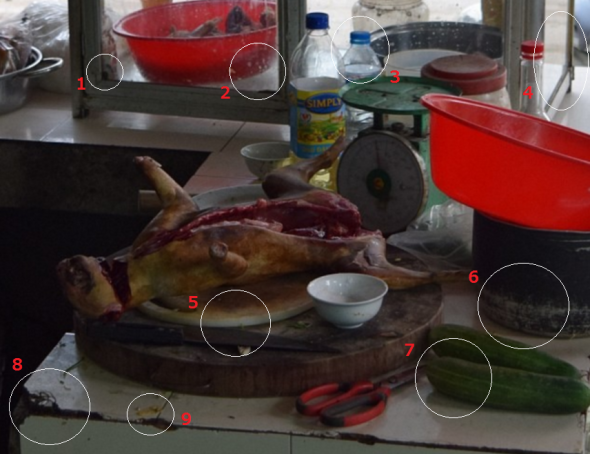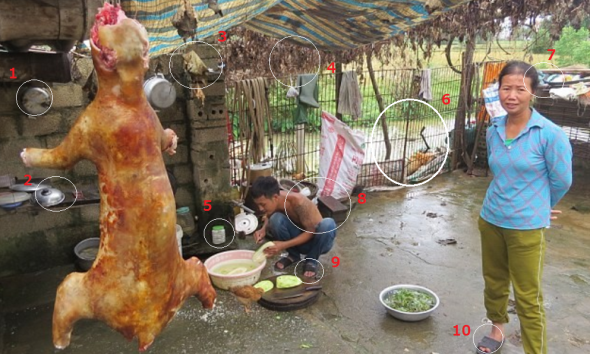Food Violations - Pet Meat Trade | Food Terrorism.
FOOD VIOLATIONS IN THE PET MEAT TRADE
One of thee biggest and most concerning problems I witness within the pet meat trade is multiple food and hygiene violations. Violations that place both human and animal life at risk of disease and in worst case scenarios - Death. Furthermore I often witness many organisations online that either disregard this critically important health risk, or seem more concerned about posting graphic images on the trade while soliciting donations, yet seemingly not bothering to educate their viewers on the “importance of these images and videos, down to how these images and videos can actually help to wipe this repulsive trade out once and for all”.
So today I have again decided to document on such violations, but am going to educate all seven million of our viewers around the world of just how serious the images depicted herein actually are. I am going to keep this document as easy reading as possible, while detailing the facts briefly but in as much detail as I can (without confusing people with scientific jargon). Below I have included a number of images within this document. The images contain small white circles that point out minor and extremely major food violations, all of which in the Western world would see such vendors and restaurants closed down immediately for placing public health at risk of contracting diseases.
FOOD VIOLATION | CROSS CONTAMINATION
Firstly I want you the reader to think - If I hadn’t of circled the most important food violations within this image below, what would you the viewer think of this image? Let me try and answer that question for you. Firstly I’d most likely be enraged that a dead feline had been slaughtered, and is now being prepared to cook to consume. And secondly, (there is no second). There is no second because my own anger, frustration and shock has overwhelmed me, of which that is all I see within this image, a dead cat, and nothing more.
I am now technically angry, and upset that someone has killed an innocent cat, and then I move onto the next image. My next thought would probably be to either leave a derogatory comment under that post, or to donate to the organisation that hasn’t shown any information or education about this image or any “graphic” pet meat trade image whatsoever.
Within the image above I have highlighted nine of the most common food violations that would be prompt any food safety inspectorate to immediately close this restaurant or vendor down within the modern western world. What are these violations? Let’s take a look.
- The window in the far left has a cracked wooden frame that bacteria would/will thrive within.
- On the right hand side of the window is mold that bacteria will grow within, that’s not forgetting the toxic spores that the mold would emit in to the ambient preparation environment thus ending up on the surrounding food itself leading to food spoilage.
- A water bottle that is possibly being used by the cook looks pretty innocent doesn’t it? Well that pretty innocent water bottle is situated next to an uncooked dead animal carcass. While the bottle may be sealed, the cook may cross contaminate that bottle with blood from the animal, simply by a single touch of his/her hand. Once the bottle is turned upside down to drink from, blood drains from that bottle into the cooks mouth which could or will see food poisoning occur from secondary cross contamination.
- The white circle in the right hand side of the image, shows an open window. While that open window may look innocent, the open window is a free entry for pests and diseases to enter into the preparation area thus spoiling the food (E.g.) flies, aphids, and parasites. Furthermore should the outside environment temperature be warmer than the inside ambient temperature, food such as meat, dairy, or cooked meats will heat up, which will see bacteria multiple on the foods spoiling them. For every twenty minutes bacteria is present, that bacteria will double in number. 1,000 bacteria = many thousands more.
- Dirty chopping boards can harbor thousands if not billions of bacteria, furthermore if this chopping board hasn’t been washed or even replaced every six months to a year, it looses its triclosan (antibacterial cover) which helps to kill off bacteria. While there is a wooden board present, that too is just as disgusting and filthy, and harboring anything from a million to a billion bacteria.
- The black bucket itself is a breeding ground for any bacteria to thrive in. The black bucket has what looks like chaff marks on of which bacteria will weed themselves out of and contaminate any food nearby.
- Vegetables that are unprepared or prepared shouldn’t be anywhere near a “raw meat preparation zone”. Vegetables and meat cooks at different temperatures, furthermore meat and vegetables require either shorter or longer periods of cooking. Salads should not under any circumstances be anywhere near “raw meat zones” whatsoever.
- Cracked tiles are the perfect breeding ground for any would be bacteria to grow. Furthermore cracked surfaces cannot be cleaned adequately which in turn leaves the area unclean. I wouldn’t even want to guess how many millions of bacteria are actually present within this single cracked tile.
- Blood and general dirty surfaces is not good food practice, and should any salad vegetables come into contact with this surface, I’d hate to think just how much bacteria the “customer” would be consuming (over that of pet meat).
The above nine food violations are commonly seen within all Asian and African unregulated food trades. These type of violations are commonly identified as (cross contamination’s). With no regulation or even monitoring of these trades, it paves the way for trillions of bacteria, diseases and virus to spawn their way into the general public’s food thus equaling food poisoning caused by human negligence.
As a human and environmental scientist I am at the best of times shocked if not perplexed at the sheer ignorance of Asian and African governments that are all up for protecting human health and safety, yet unregulated meat trades such as the above - are an imminent disaster waiting to happen on a gargantuan scale. On one end you have armed forces and police protecting people from terrorism or terrorists of which each terror atrocity kills on average 100-200 innocent civilians (Est). Yet in Asia a staggering (700,000) people die from food poisoning annually. Source: http://www.iccservices.org.uk/pdf/Food_Poisoning_Facts.pdf So I think its safe to say that food poisoning viruses are indeed the biggest threat to homeland security, something Asian and African governments seem oblivious too.
“FOOD TERRORISM KILLS 700,000 A YEAR IN ASIA ANNUALLY”
Lets leave food poisoning out of the equation now and concentrate on actual “human on human terrorism” of which in the past year terror attacks have risen by 80% in the past 365 days. Furthermore lets not forget the very (concerning 700,000 thousand innocent people), most of which are food consumers that are killed by poor food hygiene in Asia alone.
Back in 2014 the Global Terrorism Index (GTI) stated that some 32,658 people were slaughtered by terrorist attacks worldwide, totaling on average a combined 140,000 terror attacks. 2014 was marked by the (GTI) as being the largest kill rate seeing terrorist kill rates soar by some 80% in a single year from 2013-2014. Source: http://economicsandpeace.org/wp-content/uploads/2015/11/Global-Terrorism-Index-2015.pdf
The index ranks the level of terrorism in 162 countries - representing 99.5% of the world’s population - by measuring the number of attacks, injuries, deaths and property damage as a result of terror attacks. The UK ranked 28th in the index - higher than the United States, Iran and France, although the report did not include the impact of the Paris attacks in which 129 people were killed.
Terrorism remained highly concentrated in just five countries, with Iraq, Nigeria, Afghanistan, Pakistan and Syria accounting for 78% of terror-related deaths in 2014, the index found. The UK recorded the highest number of terrorist incidents of Western countries with 102 last year, although they did not result in any deaths. The majority of the attacks were in Northern Ireland and involved the New IRA, the report said.
CAN YOU SEE THE TERRORIST?
Okay, so now I am going to show you a picture below of which its very obvious what the image depicts. An armed individual that has “probably killed numerous innocent civilians”. Can you see him? Keep telling yourself, “I can see him, he’s armed and he’s certainly dangerous looking, and he’s very much within my sight”.
 CAN YOU SEE THESE TERRORISTS?
CAN YOU SEE THESE TERRORISTS?
So you can see the individual in front of you whom is holding a rifle. 2014-2015 most of the 36,000 people that were killed as a direct result of terror atrocities and/or attacks actually witnessed their aggressor before they were killed. Asian and African governments have been quoted as clamping down hard on terrorism, yet over 700,000 people a year are killed as a direct result of food terror - yet this critically important issue within the pet meat trade seems to be going ignored. 700,000 people is indeed more people killed annually than any terror attack recorded since the WWI and WWII.
In the image below what can you see? Take a good hard long look at this image. Can you see the terrorist or terrorists should I say? The answer is of course - no you cannot see them. You cannot see these terrorists or terror “suspects” as they are approximately 50 to 60 micrometers long (I.e - microbes). Lets take a look.
The image above looks pretty much innocent in the sense that there is no immediate threat whatsoever to human life. The woman to the right is not armed, and the guy to her right is going about his daily duties of food preparation. Unfortunately there are over a dozen terror suspects within this image waiting to take action on their next victim[s]. That victim could have been anyone of the 700,000 Asian citizens that consumed dog or cat meat from unhygienic premises, that poses a direct “threat to human health” in the way of “food terrorism”. So lets take a look at these non-visible, and virtually invisible terrorists.
- A dirty cooking pan hanging from a filthy brick wall. Any species of animal could have at some point took refuge on this wall. Lets say a chicken. Chickens defecate, and with chicken defecation comes germs and bacteria. Salmonella is the number one terrorist then in this situation, as salmonella can easily be passed onto humans via chicken droppings.
- An innocent (unarmed) cooking lid, looks pretty much cool, calm and collected. What’s harboring underneath that lid though, or more to the point - what has the lid been placed on? Lets say a dog has rubbed its backside up against that wall (yummy)!. What’s the likelihood of contracting a virus? High if that lid is not cleaned. and the virus is? Toxoplasma gondii is likely. The lid could be innocently placed onto or next to raw non-cooked or cooked - foods thus equaling (cross contamination).
- Dirty rags, Mmm, looks pretty much safe, and not likely to pounce or fire a quick succession of AK47 rounds off into the air. What the hell is on that rag though that’s most likely going to be used to clean pots? Flu viruses, Rhinovirus, Norovirus, E. coli, salmonella, Clostridium difficile (C. difficile) and campylobacter are all just a handful of nasty food germ terrorists that we really don’t require within our food from filthy rotten germ infested rags. Oh just for the record, Norovirus kills over 200,000 people a year. Lovely!
- Not quite sure what this is hanging down from the main food preparation area (that shouldn’t be outside). Whatever it is, its not important as such. More what has landed or took refuge on this overhanging decoration. Let’s say wild birds have visited for a brief eavesdropping, and they want to leave you a farewell present of wild-bird feces. Any food that is prepared under that overhanging decoration can become contaminated with a STAGGERING SIXTY DISEASES that you seriously do not want in your food! One of the most serious food contamination’s is that of Avian Flu that has killed many hundreds of people throughout Asia.
- Chemical contamination of food seems to be increasing within pet meat consuming countries - especially on the Asia continent. There shouldn’t be under any circumstances any form of non-food chemicals anywhere near food or within a food preparation area. Lets say this tub of unknown ingredients is “Lean Meat Powder Pork” commonly used in Asian food preparation within China. Lean Meat Powder Pork can cause - dizziness, heart palpitations, diarrhoea and profuse sweating - in worst case scenarios this substance can cause death.
- An open filthy river, again looks pretty much innocent. However any insect such as flies can simply swoop in for a mere taste of the local specialties thus spoiling food. That innocent fly could have anything on its pads from animal dung to dog feces. The most common virus a fly could leave is that of a vomiting virus. Not really what I’d call “good customer service”.
- Hairnets must always be worn within food preparation and raw meat preparation. While there is no real major food terrorist here the woman could have touched a bloodied animal carcass, then patted her hair down. That means a cross contamination of a virus of some sort. Lets say she has touched raw pork, and then goes over to inspect the local ‘cooked dog or cat meat’. She brushes her hair again, and a loose hair follicle contaminated with raw pork blood ends up in food that doesn’t require cooking or further cooking, Hepatitis E viruses, Trichinosis, and Ecoli, are three of many viruses that can end up in food causing severe and unwanted sickness, simply by not wearing a hair net.
- The guy to the innocent woman’s right is again not really looking dangerous, apart from the fact that he has no T-Shirt on or even a protective food apron which is pretty much vile and a 100% food violation within the Western world. Aprons stop anything from hair, skin cells, down to human viruses from being passed onto the food. Furthermore gloves are not being worn for the “average of twenty minutes” that would keep a barrier in between the food prep and the food. Most common types of food virus are vomiting and cold bugs.
- Improper foot-ware is not being used within a food preparation area, which could in this case pose a danger “to the food server and preparatory individual”. We know that rabies is very problematic within Asia and accounts for thousands of deaths every year. Should anyone of the (live or dead stolen pets), be infected with rabies, and the man with no proper and safe foot-ware have open wounds on his feet, he’s likely to contract the deadly rabies virus equaling death!
- And finally in at number ten, as like the young man on the floor preparing food, the woman is also wearing open toed shoes which is again a big no no within food preparation or any food service. Unwashed nails contain the natural microflora or resident bacteria and microbes and the transient bacteria from the objects that the hands come in contact with. When the hands are unwashed, there are millions and millions of bacteria living and growing on it. And you really don’t want them bacteria in your food.
CAN YOU SEE THE FOOD TERRORIST NOW?
The whole purpose of this article is to educate not discriminate. Over 700,000 people die every-year in Asia alone from food viruses, and food contamination. That’s 700,000 too many of which The Anti Pet & Bush Meat Coalition are trying to stop in relation to the virus filled dog and cat meat trade. Please sign the petition below and help by donating via the link.
Donate here:
https://www.facebook.com/Anti-Pet-and-Bush-Meat-Coalition-474749102678817/app/117708921611213/
Sign the petitions here on Facebook:
https://www.facebook.com/474749102678817/photos/pb.474749102678817.-2207520000.1452824282./554473384706388/?type=3&theater
Follow us on Facebook here:
https://www.facebook.com/Anti-Pet-and-Bush-Meat-Coalition-474749102678817/
My name is Dr Jose. C. Depre and thank you for reading.
Dr Jose C. Depre PhD. MEnvSc. BSc(Hons) Botany, PhD(NeuroSci) D.V.M.
Environmental & Human Science
Environmentalism - Chapter 36 Bird Flu
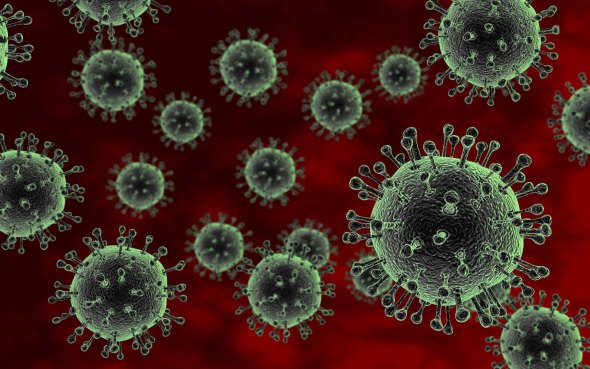
In China eight people have so far died and at least 16 are seriously ill in the latest outbreak of bird flu H7N9. However as this information went to press today 13th April 2013 it is now feared that the death toll could even be higher than expected to even rising now out of control.
The death toll could even rise higher because the virus has already three of the five mutations that we know would allow another bird flu outbreak H5N1 to spread between mammals which is now seen by ourselves and others as a “category 1 environmental concern” the highest warning level given for this type of virus outbreak within the environmental, agricultural and medical world.
No one knows for sure if the five mutations discovered last year by Dr Ron Fouchier and colleagues at Erasmus Medical Centre in Rotterdam, the Netherlands will do the same thing in H7N9. But we do know that some form of the mutations helped viruses from three other influenza families go “pandemic” which is very concerning as this explains to us that the virus is traveling rapidly and will soon if not brought under control cause a catastrophic loss of mammal and non- mammal life.
Chinese authorities are at this moment tracing contacts of known cases to see whether the infection has already spread between humans. Two more people with H7N9 only show mild symptoms, so the authorities are trying to establish how often it makes people seriously ill.
Most recent pandemic viruses have been hybrids of birds and mammalian flu, and therefore relatively mild because mammalian influenza tends to be less severe in people than bird flu. Pure bird flu viruses, like H5N1, and H7N9, are more potentially dangerous. The most lethal pandemic we know of, which spread across the world in 1918, was a pure bird flu that acquired mutations that allowed it to spread in humans, Virologists fear that the H5N1 has spread widely in birds, but it has not evolved the ability to spread rapidly between mammals (as yet).
Dr Fouchier’s work – which came under fire because of fears that it would allow bioterrorists to engineer an H5N1 pandemic shows that in principle, is can spread between ferrets, with no obvious loss of virulence.
To get transmissible H5N1, Fouchier first had to prime the virus with three mutations known to adapt bird flu to mammals, and then allow the other two requisite mutations to evolve within the animals. Two of the three deliberately added mutations allow the HA surface protein from bird flu in the H5, H2 and H3 families to bind to cells in mammalians noses. The viruses that broke out in 1918 from the H1 family – had similar mutations with the same effect.
Such binding mutations have never have never been seen in the wild H5N1 – but H7N9 already has one of the two. If the H7N9 can bind to mammalian cells it could adapt even further to mammals, just as Fouchier’s primed H5N1 did in his ferret experimentations.
If what we know about these mutations in other flu subtypes is also the case for this virus, then it’s already part way there, of which the University of Cambridge confirmed too which now has many environmentalists, scientists and medical practitioners to hospitals extremely worried and we have a right to be concerned now as of this evidence and further investigations that are still continuing.
The viruses also has a second of Fouchier’s mutations in a polymerase protein which allows the powerful replicating enzyme that makes bird flu so virulent to work at mammalians temperatures. This mutation has been present in all pandemic viruses.
The third mutation in H7N9, which led to the spread of the H5N1 in Fouchier’s work removed a sugar group from the HA. That leaves only two more mutations, both in HA, before this H7N9 has Fouchiers five.
All pandemic viruses have acquired this [mammalian cell] binding and polymerase activity stated “Fouchier”. “The H7N9 has these characteristics so the question now is what else does it need - if anything?
General Viral Information
Many experts warn that the world is overdue, and unprepared, for a global influenza pandemic. The next outbreak could well be as deadly as the Spanish flu, also known as H1N1, and potentially leave tens of millions dead.
Currently experts can’t determine exactly which viruses might spark pandemics, though the Spanish flu data may help to identify which strains bear close observation.
H5N1, a strain of avian influenza called the bird flu, is the most likely candidate. The largely Southeast Asian disease is commonly found in birds but also occurs in mammals like pigs, cats, and humans. It has killed several dozen people, but as of yet it cannot be easily transferred from person to person and so has not developed into a pandemic outbreak.
MIT researchers have explained why two mutations in the H1N1 avian flu virus allowed the disease to spread during the 1918 pandemic that killed at least 50 million people. The work could help scientists detect and contain a future bird flu outbreak among humans.
The team showed that the 1918 influenza strain developed two mutations in a surface molecule called hemagglutinin (HA). This, in turn, allowed it to bind tightly to receptors in the human upper respiratory tract.
This new work could aid researchers in monitoring the HA mutations in the H5N1 avian flu strains currently circulating in Asia. Epidemiologists fear these mutations could enable the virus to jump from birds and spread between humans-a possibility that could trigger millions more deaths than the 1918 pandemic.
Ram Sasisekharan, the Underwood Prescott Professor of Biological Engineering and Health Sciences and Technology, is the senior author of a paper on the work published in the Feb. 18 issue of the Proceedings of the National Academy of Sciences.
In January, Sasisekharan and colleagues reported in Nature Biotechnology that flu viruses can only bind to human respiratory cells if they match the shape of sugar (or glycan) receptors found on those cells. The glycan receptors found in the human respiratory tract are known as alpha 2-6 receptors, and they come in two shapes-one resembling an open umbrella, and another resembling a cone. To infect humans, the MIT team found that avian flu viruses must gain the ability to bind to the umbrella-shaped alpha 2-6 receptor.
In the current study, the team discovered that two mutations in HA allow flu viruses to bind tightly or with high affinity to the umbrella-shaped glycan receptors. “The affinity between the influenza virus HA and the glycan receptors appears to be a critical determinant for viral transmission,” said Sasisekharan.
The researchers used the 1918 influenza virus as a model system to investigate the biochemical basis for hemagglutinin binding to glycans, which leads to viral transmission. They compared the virus that caused the 1918 pandemic (known as SC18) with a strain called NY18, which differs from SC18 by only one amino acid, and also the AV18 strain, which differs from SC18 by two amino acids.
Using ferrets (which are susceptible to human flu strains), researchers had earlier found that, while SC18 transmitted efficiently between ferrets, NY18 is only slightly infectious and AV18 not at all infectious.
These earlier findings correlate with the viruses’ ability to bind to umbrella-shaped alpha 2-6 glycan receptors, demonstrated in the current PNAS study. NY18, which is only slightly infectious, binds to the umbrella-shaped alpha 2-6 receptors, but not as well as SC18, which is highly infectious.
AV18, which does not infect humans, does not have any affinity for the umbrella-shaped alpha 2-6 receptors and binds only to alpha 2-3 receptors. Another strain, TX18, binds to alpha 2-6 and alpha 2-3 but, because it binds with high affinity to the umbrella-shaped alpha 2-6 receptors, is much more infectious than NY18.
Researchers from the Centers for Disease Control and Prevention reported on the varying infectiousness of these strains last year, but the PNAS study is the first that explains the exact biochemical reason underlying these differences.
Other authors of the PNAS paper are Aravind Srinivasan and Karthik Viswanathan, postdoctoral associates in MIT’s Department of Biological Engineering (BE); Rahul Raman, research scientist in BE; Aarthi Chandrasekaran, graduate student in BE; S. Raguram, visiting scientist in BE; Viswanathan Sasisekharan, visiting scientist in the Harvard-MIT Division of Health Sciences and Technology; and Terrence Tumpey of the Centers for Disease Control and Prevention.
The research was funded by the National Institute of General Medical Sciences and the Singapore-MIT Alliance for Research and Technology (SMART).
Influenza H5N1 Threat to the Environmental World
In nature, influenza viruses circulate continuously among animals, especially birds. Even though such viruses might theoretically develop into pandemic viruses, in Phase 1 no viruses circulating among animals have been reported to cause infections in humans.
In Phase 2 an animal influenza virus circulating among domesticated or wild animals is known to have caused infection in humans, and is therefore considered a potential pandemic threat.
In Phase 3, an animal or human-animal influenza reassortant virus has caused sporadic cases or small clusters of disease in people, but has not resulted in human-to-human transmission sufficient to sustain community-level outbreaks. Limited human-to-human transmission may occur under some circumstances, for example, when there is close contact between an infected person and an unprotected caregiver. However, limited transmission under such restricted circumstances does not indicate that the virus has gained the level of transmissibility among humans necessary to cause a pandemic.
Phase 4 is characterized by verified human-to-human transmission of an animal or human-animal influenza reassortant virus able to cause “community-level outbreaks.” The ability to cause sustained disease outbreaks in a community marks a significant upwards shift in the risk for a pandemic. Any country that suspects or has verified such an event should urgently consult with WHO so that the situation can be jointly assessed and a decision made by the affected country if implementation of a rapid pandemic containment operation is warranted. Phase 4 indicates a significant increase in risk of a pandemic but does not necessarily mean that a pandemic is a forgone conclusion.
Phase 5 is characterized by human-to-human spread of the virus into at least two countries in one WHO region. While most countries will not be affected at this stage, the declaration of Phase 5 is a strong signal that a pandemic is imminent and that the time to finalize the organization, communication, and implementation of the planned mitigation measures is short.
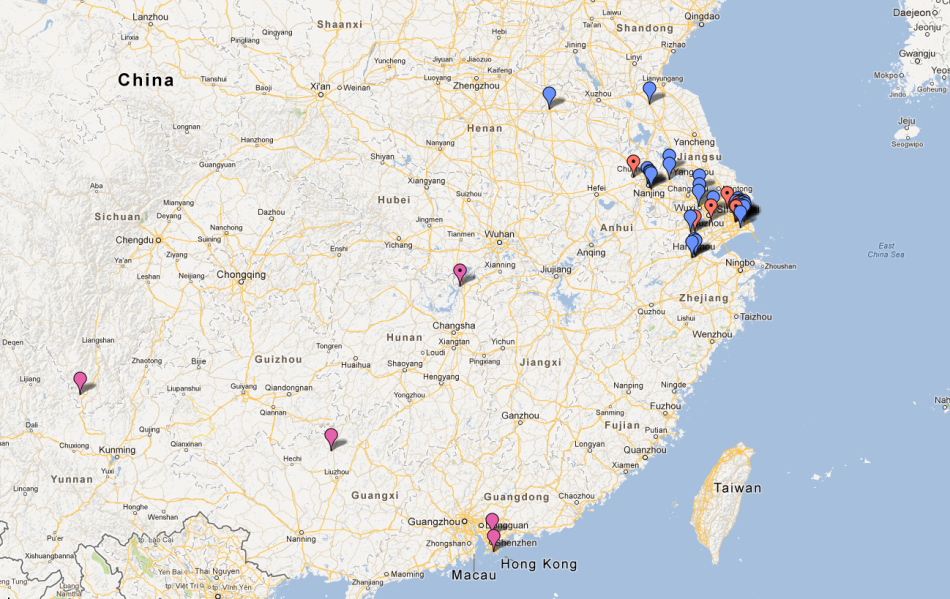
Picture above indicates deaths and seriously ill so far to date 13th April 2013 (12:08pm)
Phase 6, the pandemic phase, is characterized by community level outbreaks in at least one other country in a different WHO region in addition to the criteria defined in Phase 5. Designation of this phase will indicate that a global pandemic is under way. During the post-peak period, pandemic disease levels in most countries with adequate surveillance will have dropped below peak observed levels. The post-peak period signifies that pandemic activity appears to be decreasing; however, it is uncertain if additional waves will occur and countries will need to be prepared for a second wave.
Previous pandemics have been characterized by waves of activity spread over months. Once the level of the disease activity drops, a critical communications task will be required to balance this information with the possibility of another flu outbreak wave, pandemic waves can be separated by months and an immediate “at-ease” signal may be premature.
In the post-pandemic period, influenza disease activity will have returned to levels normally seen for seasonal influenza. It is expected that the pandemic virus will behave as a seasonal influenza A virus. At this stage, it is important to maintain surveillance and update pandemic preparedness and response plans accordingly. An intensive phase of recovery and evaluation may be required.
Biological Terrorist Threat
Could the below information be related to the recent high poaching rate’s in South Africa?
Report received 9th April 2013;
Colonel Sr. Col. Dai Xu
A Chinese Air Force officer on Saturday accused the U.S. government of creating the new strain of bird flu now afflicting parts of China as a biological warfare attack.
People’s Liberation Army Sr. Col. Dai Xu said the United States released the H7N9 bird flu virus into China in an act of biological warfare, according to a posting on his blog on Saturday.
The charge was first reported in the state-run Guangzhou newspaper Southern Metropolis Daily and then picked up by several news outlets in Asia. State Department spokesman Jason Rebholz dismissed the claim. “There is absolutely no truth to these allegations,” he told the Washington Free Beacon. Seven deaths from the bird flu outbreak were reported as of Tuesday in state-run Chinese media. As many as 24 people reportedly were infected by the disease in Shanghai, Jiangsu, Zhejiang, and Anhui.
Chinese authorities are trying to calm public fears of a major epidemic, claiming there is no evidence the virus can be transmitted between humans (this is untrue though and why was the American government so angered at Dr Fouchier’s work?). The government also is claiming that the outbreak is not related to the recent discovery of thousands of dead pigs floating in a river in China.
The accusation of U.S. biological warfare against China comes as the Pentagon is seeking closer military relations with China. Army Gen. Martin Dempsey, chairman of the Joint Chiefs of Staff, is set to travel to China for talks with Chinese military leaders later this month.
Dai is a military strategist who in the past has been outspoken in seeking to foment conflict between China and the United States. He told the Global Times in August that China should go to war over U.S. support for Japan’s claims to the disputed Senkaku Islands.
Writing on Sina Weibo, a Chinese micro blogging site akin to Twitter, Dai stated that the new bird flu strain was designed as a biological weapon similar to severe acute respiratory syndrome (SARS), which he also claimed was developed as a U.S. bio-weapon that affected the country in 2003. http://gulfnews.com/about-gulf-news/al-nisr-portfolio/weekend-review/mystery-prevails-over-sars-like-condition-1.1166534 - http://en.wikipedia.org/wiki/SARS_conspiracy_theory the whistle blower is now in fear of his life http://en.wikipedia.org/wiki/Sergei_Kolesnikov_(whistleblower) along with others. Many whistle blowers have either had to exile or have been found dead such as the whistle blower of Operation Black Swan (we have kept this information of line) however you can Google research that. http://now.msn.com/dai-xu-chinese-colonel-says-us-is-behind-bird-flu-outbreak-in-china
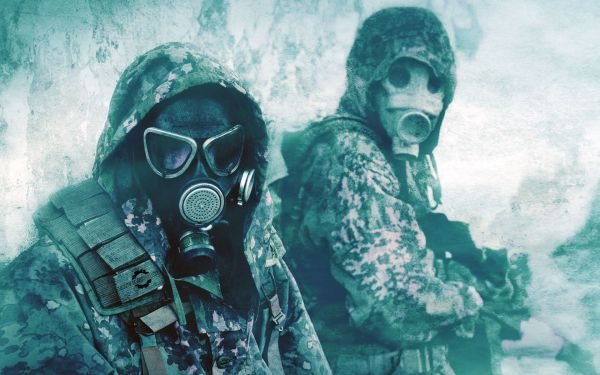
According to Dai’s posting, the new flu outbreak should not be a cause for concern. “The national leadership should not pay too much attention to it,” the PLA lecturer at the National Defence University wrote. “Or else, it’ll be like in 2003 with SARS!”
“At that time, America was fighting in Iraq and feared that China would take advantage of the opportunity to take other actions,” he said. “This is why they used bio-psychological weapons against China. All of China fell into turmoil and that was exactly what the United States wanted. Now, the United States is using the same old trick. China should have learned its lesson and should calmly deal with the problem.” Dai said that even if “a few may die” from the flu outbreak, it will not equal one-thousandth of the deaths caused by vehicle accidents in China.
Dai in the past has called for China to punish the United States for U.S. arms sales to rival Taiwan, by selling arms to U.S. enemies. “China recognizes that a few perfunctory protests will not have any effect,” Dai said in 2010. “China can’t directly sanction American arms companies since they did not do business with China … but China can sanction companies that are doing business with China directly, like Boeing or General Electric.”
Dai also has said the United States has used crises with North Korea and offers of cooperation on the issue as a plot to drive a wedge between Beijing and its fraternal communist ally. Dai also has said U.S. efforts to counter Chinese espionage and intelligence-gathering were part of a U.S. “plot theory” of “western countries threatening others by [releasing] information gained through spying in order to damage the reputations of other countries.”
A State Department official said China notified the World Health Organization (WHO) on March 31 about its first detected human cases of H7N9 infection. Fourteen cases were confirmed by the WHO by April 5, of which six were fatal. The organization said there is no evidence of human-to-human transmission.
“U.S. Embassy Beijing and U.S. Consulate Shanghai are monitoring the situation, working closely with counterparts at the U.S. Centers for Disease Control, and the Beijing and Shanghai municipal governments,” the official said.
The colonel’s accusation provoked a widespread response on Chinese websites. One post in reaction joked that Dai’s comment about auto deaths must mean that the United States and Germany are responsible for a conspiracy to produce cars, according to a report in Hong Kong’s South China Morning Post.
Luo Changping, deputy editor of Caijing, said most PLA soldiers would not support Dai’s comments and he urged the colonel to resign and apologize to those who have died from the current bird flu outbreak.
A defiant Dai then said in a new posting Sunday that “it is common knowledge that a group of people in China have been injected with mental toxin by the United States.” “Now, a group of fake American devils are attacking me,” he wrote in another post. “I will not retreat even half a step.”
Analysts say the colonel’s remarks are a reflection of the growing xenophobic atmosphere within the Chinese military that views the United States as its main enemy.
Former State Department intelligence analyst John Tkacik said China’s military was largely to blame for mishandling the 2003 outbreak of SARS. Tkacik said there was speculation when the epidemic began that “the PLA suspects SARS had emanated from its own biological laboratories and was all the more eager to keep it secret.” China is known to have a covert biological arms program.
“Col. Dai Xu is a shameless liar when he accuses the United States of using bio weapons,” Tkacik told the Free Beacon. “He’s probably motivated by a desire to exculpate the PLA for their mishandling of the epidemic—no doubt most Chinese have happily forgotten the episode—as much as by a cynical xenophobia. But, that’s what passes for deep strategic thought at China’s National Defense University these days.”
The Pentagon has been trying with varying success to develop closer ties to the Chinese military as part of a strategy aimed at building trust. However, China’s military leaders believe the U.S. offers of closer ties are a ruse designed to contain China’s growing military build-up. Defence Secretary Chuck Hagel spoke by phone with China’s Defence Minister Gen. Chang Wanquan on April 2. Chang is the No. 4 defence official after Chinese President Xi Jinping and two other generals who run the Central Military Commission, the Communist Party’s ultimate power organ. “The leaders both expressed their intention to work together to continue to build a military-to-military relationship that serves the vision of both President Obama and President Xi,” Pentagon press secretary George Little said in a statement after the call.
“The secretary discussed the importance of focusing on areas of sustained dialogue, practical areas of cooperation, and risk reducing measures,” he said. U.S. ties with China are strained due to China’s reluctance to rein in neighbouring North Korea.
China provides North Korea with large amounts of fuel oil and other goods. However, Beijing has not taken steps to pressure Pyongyang using its economic leverage during the on-going crisis.
The flu has lit up China’s thriving Internet, according to analysts. Over 945,600 micro blog postings addressed the flu between April 8 and 9. Since the outbreak began some seven days ago, between 1.3 million and 3 million postings were put online on outlets including Sina Weibo and QQ Weibo.
Tens of thousands of users expressed doubts about the official Shanghai municipal government’s denial of any link between the dead pigs found floating last month in the region’s Huangpu River.
The proximity to the initial outbreak in Shanghai and the river has led to speculation that the pig deaths may have been linked to the flu virus jumping from animals to humans. That speculation was fueled by reports that one of the victims of the flu was a pig butcher.
The avian flu strain is similar to an earlier outbreak with a significant difference: The current strain does not kill the birds it infects, making it more difficult to identify infected poultry. The Shanghai government waited 20 days before announcing the first H7N9 infection on March 31.
Threat to human life
13th April 2013
A genetic analysis of a bird flu strain responsible for at least nine human deaths in China suggests it could evolve to adapt to human cells, researchers say.
A study led by researchers from Japan’s National Institute of Infectious Diseases with colleagues at the University of Wisconsin-Madison examined the genetic sequences of the H7N9 pathogen from four of the human victims as well as samples derived from birds and the environs of a Shanghai market.
“The human isolates, but not the avian and environmental ones, have a protein mutation that allows for efficient growth in human cells and that also allows them to grow at a temperature that corresponds to the upper respiratory tract of humans, which is lower than you find in birds,” UW-Madison researcher Yoshihiro Kawaoka said.
Although it is too early to predict its potential to cause a pandemic, Kawaoka said, signs the virus is adapting to mammalian and, in particular, human hosts are unmistakable. Avian influenza rarely infects humans but can sometimes adapt to people, posing a significant risk to human health, the researchers said.
“These viruses possess several characteristic features of mammalian influenza viruses, which likely contribute to their ability to infect humans and raise concerns regarding their pandemic potential,” Kawaoka and his colleagues reported.
The first human cases were reported on March 31 by the Chinese Center for Disease Control and Prevention, and the new virus has sickened at least 33 people, killing nine.
Dr J C Dimetri Director & International Delegates
www.international-animalrescue-foundation.org.uk
Stay up to date on African Affairs –
https://www.facebook.com/pages/International-Animal-Rescue-Foundation-World-Action-South-Africa/199685603444685?fref=ts
Contact us for more information or to request a media article;
http://www.international-animalrescue-foundation.org.uk/general-enquiries/


